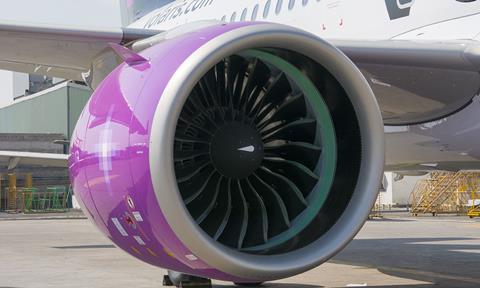Mexican ultra-low-cost carrier Volaris is facing an uphill battle in 2024 as it deals with a capacity shortfall caused by a substantial part of its Pratt & Whitney-powered narrowbody fleet being out of service for much of the year.
Chief executive Enrique Beltranena told an investor webcast on 23 April that during the first quarter of 2024, the Mexico City-based airline had 60 engines off-wing, and was forced to ground an average of 29 aircraft due to the accelerated inspections required by the PW1100G powerplants.
“Despite Pratt & Whitney’s optimistic discourse on enhancing MRO capacity and availability of materials and spare parts, Volaris remains sceptical about tangible progress in this area,” Beltranena says.
“While engine removals to date have gone according to schedule, we are being conservative in our expectations on when engines will return to service.”
The uncertainty has required the airline to “make rapid strategic adjustments” in its schedule and capacity plans this year.

Airline executives say that the biggest crunch will come in the third quarter and early fourth quarter this year when Volaris anticipates it will have the largest number of engines out for repair.
“So it’s important that I don’t want you guys to get bullish because we remain sceptical on what is coming regarding engines in the fourth quarter,” Beltranena tells analysts.
He says that the carrier had delivered to P&W the first nine engines to be inspected “before September 15” last year. With an average of “350 days or a little bit more” of work, Volaris expects those powerplants to be returned “sometime in the fourth quarter this year”.
In December, the airline said it had reached compensation agreement with P&W, which it did not quantify. That agreement “will help address fixed costs associated with the engines during inspections”.
Beltranena speculates that part of the delay can likely be attributed to supply chain issues.
“[Pratt] is probably in the highest peak of engines in terms of maintenance, “ he says. “All of these engines are removed now and in the process of being repaired. The issue here is, how fast is Pratt inducting engines into shops, and once they are in the shop are they really being inducted, or are they waiting for spare parts and materials?”
Even though the engine problems will be a constant accompaniment to the year’s business, Volaris is seeing “healthy spring and summer booking trends… as we enter the peak season”, Holger Blankenstein, Volaris’ chief commercial officer, adds.
Bookings in April were, however, lower, since Easter fell on 31 March this year, much of the holiday travel period for visiting friends and family traffic occurred in the first quarter.
About 45% of the airline’s network is to the lucrative US market – that’s about 15 percentage points higher than it had been historically, he adds.
“While we are experiencing strong demand, we are navigating the challenges caused by the accelerated inspection process.”
Earlier in the day the company disclosed a first-quarter profit of $33 million – its first since 2019 – as the company kept a sharp eye on costs. Revenue during the three months ended 31 March was $768 million, up 5.1% from the same period in 2023.
At the end of the first quarter, the carrier had 134 aircraft in its all-Airbus narrowbody fleet, five more than at the end of last year.
For the full year 2024, the airline maintains its expectations that capacity will decline by 16-18% due to the P&W engine inspections. In the second quarter, the figure is expected to be closer to 18%. By contrast, the airline increased capacity 18.1% in the second quarter of 2023, and by 10% for the full year.


























